Dell U2412M - 16:10 IPS without Breaking the Bank
by Chris Heinonen on February 28, 2012 9:00 AM ESTDell U2412M Color Quality
With that long write-up out of the way, you might expect that there was something in particular to the U2412M that led me to explain our testing and results. There initially was but it actually proved to be a software issue; still, I thought the explanation on the previous page would be useful for everyone. For our uncalibrated measurements, I used the profile included on the CD, set the brightness to 200 nits, and then measured using the i1Pro meter.
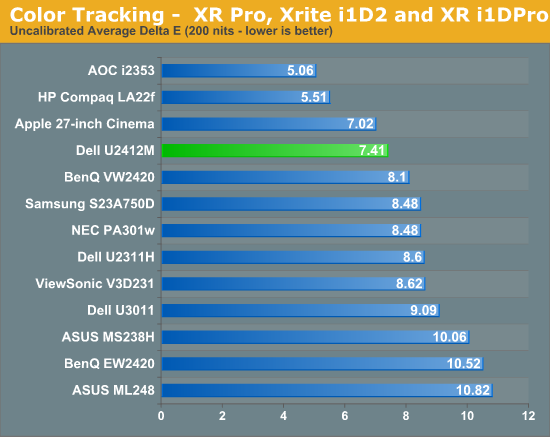
Here we see a score over 7, which is about what we expect to see on a monitor straight out of the box. Comparing this to previous displays isn’t easy to do as most of those used the i1Display2, which isn’t nearly as accurate as the i1Pro is. Of course, all displays do better once calibrated, so I kept the brightness target at 200 nits, with a white point target of D65, gamma of 2.2, and minimum black target.
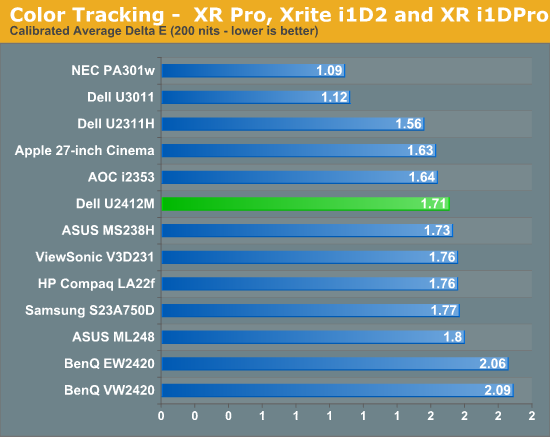
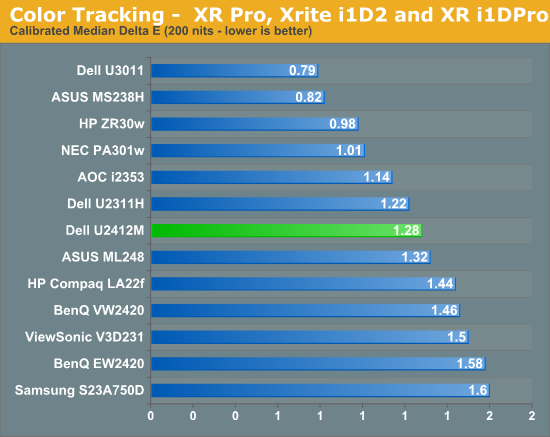
The errors for the Dell look very similar to what we have seen on other monitors. The color gamut is not AdobeRGB, so some of the patches are outside of the range for the display and can’t be rendered correctly. This leads to the spikes in the chart for blue samples and the higher average dE. We included the median dE number so you can see that the value drops quite a bit if we look at that. Everything other than blue is pretty good, and the grayscale is right around 1. So this is nice overall, though not perfectly accurate due to the color gamut and possibly due to the 6-bit panel. Now we will profile again to see if the results are similar with a target of 100 nits instead of 200 nits.
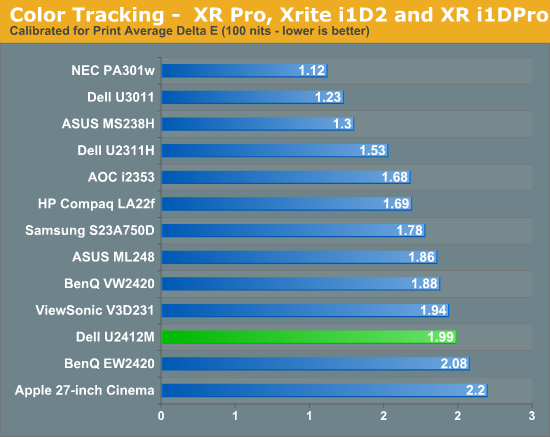
The error seems to rise a bit here, most notably in the grayscale that you would want to keep very neutral for print work. Most colors stay below 3.0 in their error (which is considered the threshold of being visible to the naked eye in motion) but again the blues are past that and errors would be visible to someone that was looking. For serious print work, you probably need to look for something that can use the full AdobeRGB gamut.



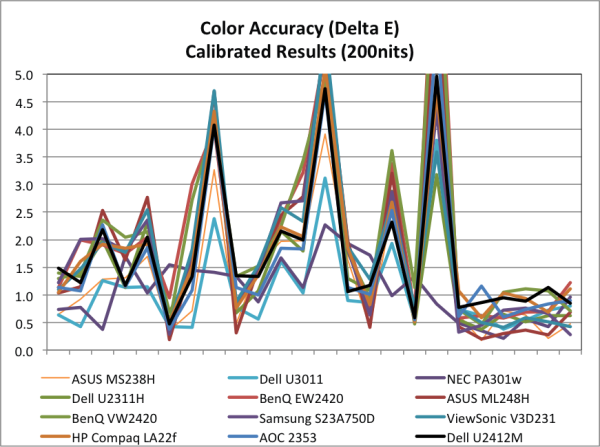
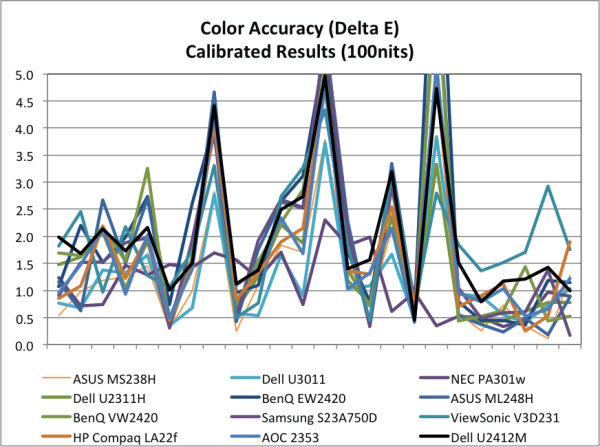








143 Comments
View All Comments
kchase731 - Thursday, March 1, 2012 - link
I have 2 of these side by side on my desktop. I bought them for $299 ea. free shipping. im very very pleased with them. I replaced 2 aging dell 2405's and these look really good. Im not a graphic designer or developer or gamer, i use them for work I like having the desktop real estate and these accomplish that well, maybe not perfect but like i said im not a designer and they seem very good for the money. i used a colorimeter to calibrate them, they seem accurate and crisp, im very happy with the purchase, and am strongly considering adding a 3rd.mike8675309 - Thursday, March 1, 2012 - link
Get this resolution into a 21" display and have it be at least as good as this and I'd buy a pallet of them to hold me over until retirement. At a 24" size, I'll just take two as it really is just too big to be perfect. As a software programmer (more actual code, less pretty widgets) those extra lines of resolution are valuable.Now if the company I'm working for today would just let me buy my own monitors.
Mithan - Thursday, March 1, 2012 - link
I purchased this monitor back during the Black Friday sale they had in November and I love it.It sits next to my Dell 2407WFP which I love as well and replaces some crappy 24" Samsung TN panel that died on me.
My only complaint with the LCD is that the vertical viewing angle isn't as good as the 2407WFP.
However, for heavy gaming and web browsing, it has been an excellent LCD and I am tempted to buy a second to replace the 2407 that is taking longer to reach full brightness than it used too.
Its a kick ass LCD, especially for $300. I would recommend it to any gamer in a heart beat that doesn't want a crappy TN panel but doesn't want to spend $500 either.
mtoma - Friday, March 2, 2012 - link
I also thought that 120 Hz is good for movies, I even bought an LG and I watched movies in 120 Hz, for that reason only. Well, the movement scenes are .. uncanny, the feel like I watch some theatre piece, are toooo fluid. The action/movement scenes feel rushed. Too rushed. And, it makes sense: the movie, released to users in 23-24 frames/second, looks best on lower refresh rate panels.Of course, in other desktop applications (games, Internet, office apps), that refresh rate does not ruin the experience, it is ok. But in movies... no way, no way.
On the subject of panel-integrated webcams, I agree that they suck. But, I believe that in smartphones (the expensive ones - Nokia Lumia 800 for example) they don't suck, actually are pretty good. So, I feel that desktop enthusiasts deserve the best technology possible. I really think that with a bit of effort, the PC world can match and even surpass the Apple world in technology and design (the design and the component consolidation are the reasons I wish a good integrates webcam in LCD-s/OLED's).
sethsez - Thursday, March 8, 2012 - link
You're wrong about movies. Unless there's some interpolating going on (which might very well be the case), 120 Hz should be significantly BETTER for 24 FPS material than 60 Hz.The thing is, 24 doesn't divide evenly into 60. So you wind up getting unevenly repeated frames in order to match the monitor's refresh rate. Meanwhile, with 120 Hz you can repeat each frame 5 times and be done with it, ensuring an equal level of time between each unique frame.
What you saw was almost certainly interpolation, in which the monitor actually attempts to create new frames in between the original ones. It looks like garbage and has given 120 Hz a bad rap it doesn't deserve.
woodelf - Friday, March 2, 2012 - link
Here's my problem with this review and others (of both this monitor and others): I have no basis of comparison. Other than the Apple monitors, I have never even seen an 8-bit IPS monitor in person. And the last time I got to play around with an Apple display enough to determine how the color was (not as good as my CRT) was 2-3 generations ago. Best Buy doesn't stock anything but crap for monitors, and ditto for every other store I've managed to get into. Likewise, work monitors are (1) all cheap Dells and (2) running XP and ugly custom-built software, and I'm not doing any design work on them in any case, so I don't have anything to really judge against.Unfortunately, all I know from reviews is that S-IPS > eIPS > TN, and TN isn't good enough for my eyes. What I *do* know is CRT monitors (I'm a little behind the times). So, can anybody compare the color fidelity of an eIPS to a quality CRT (ideally my slowly-dying Sony GDM-FW900)? I get that S-IPS or H-IPS would definitely be preferable, and I suspect I could see the difference, at least in some circumstances. But this monitor is much more comfortable for my budget, so if it's "good enough", the sacrifice in quality is probably worth it to me. From looking at screenshots in reviews, I really can't tell the difference between a well-calibrated U2412M and U2410--but I don't expect that is representative of actually sitting in front of the monitors.
GullLars - Saturday, March 3, 2012 - link
I've been using this as one of 3 monitors for 8 months now, and i'm very happy with it.My main monitor is a Dell Ultrasharp 27" (2560x1440), and i have this U2412M and another monitor in portrait mode (flipped) on either side. Upgrading from two old TN monitors, 1x 24" 1900x1200 and 1x 22" 1680x1050, using the new configuration is great.
Using these U2412M vertically for reading documents and web sites are great. It gives a much more "roomy" feeling.
jiffylube1024 - Sunday, March 4, 2012 - link
I've got the Dell Ultrasharp 709W -- it's a 16:10 27" LCD with a 1920x1200 panel. If they did a 27" 1920x1200 eIPS for a cheap price (<$500) I'd get it in a heartbeat, and I'd bet it would be a huge seller.kunstderfugue - Tuesday, March 6, 2012 - link
Something i don't understand is: How is 16:10 better than 16:9? In the end, it's only 120 more lines; and i don't see how that makes for a better experience.woodelf - Thursday, March 15, 2012 - link
It's not just 120 lines, it's also an inch (or so, depending on the overall monitor size). In the case of a 24" monitor, that extra inch makes it possible to see an A4 or letter-size two-page book spread at actual size, and still see your menu bars. In fact, the 16:10 aspect ratio is almost perfect, with a little room on one side for some pallets or tool bars.